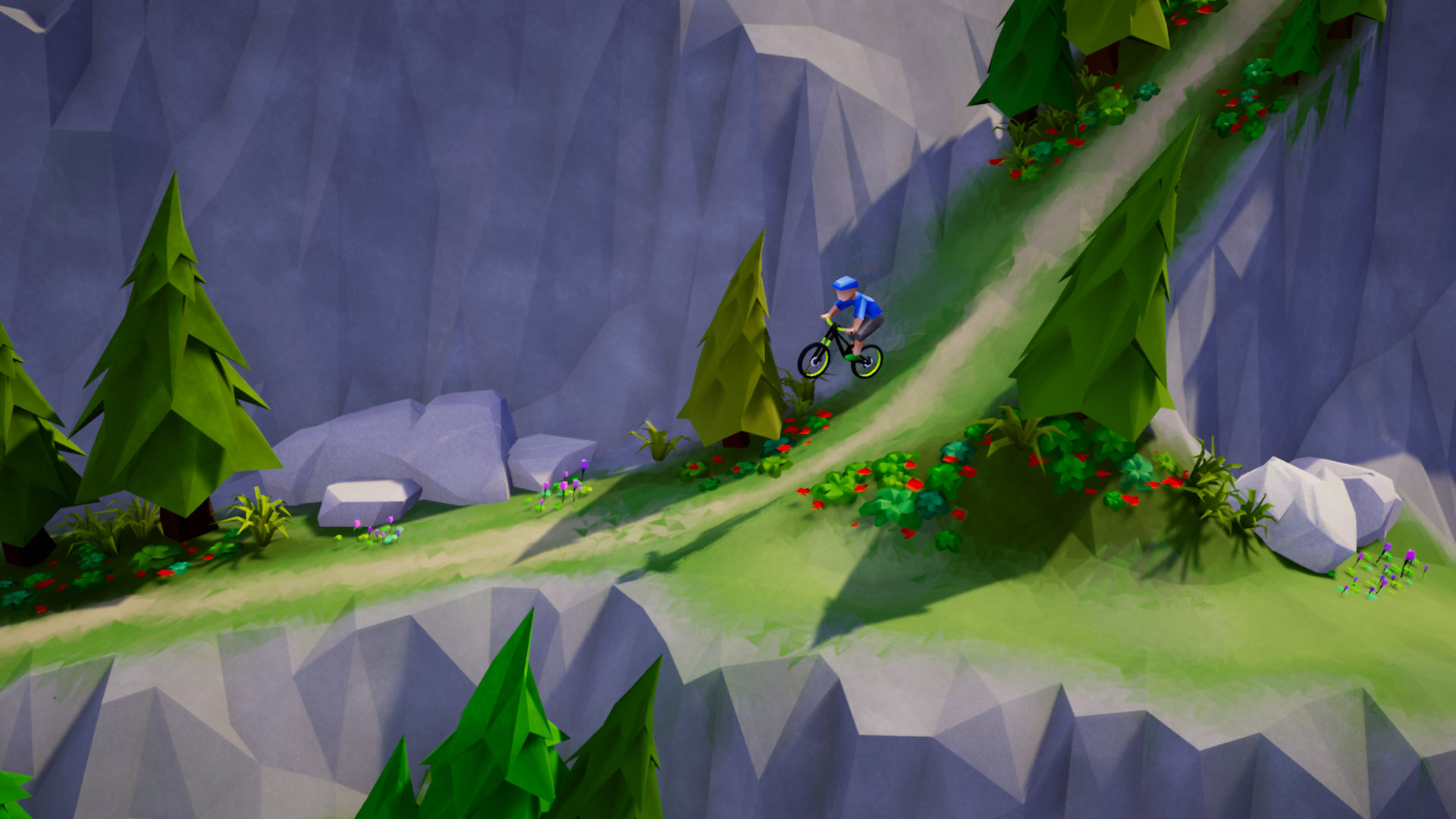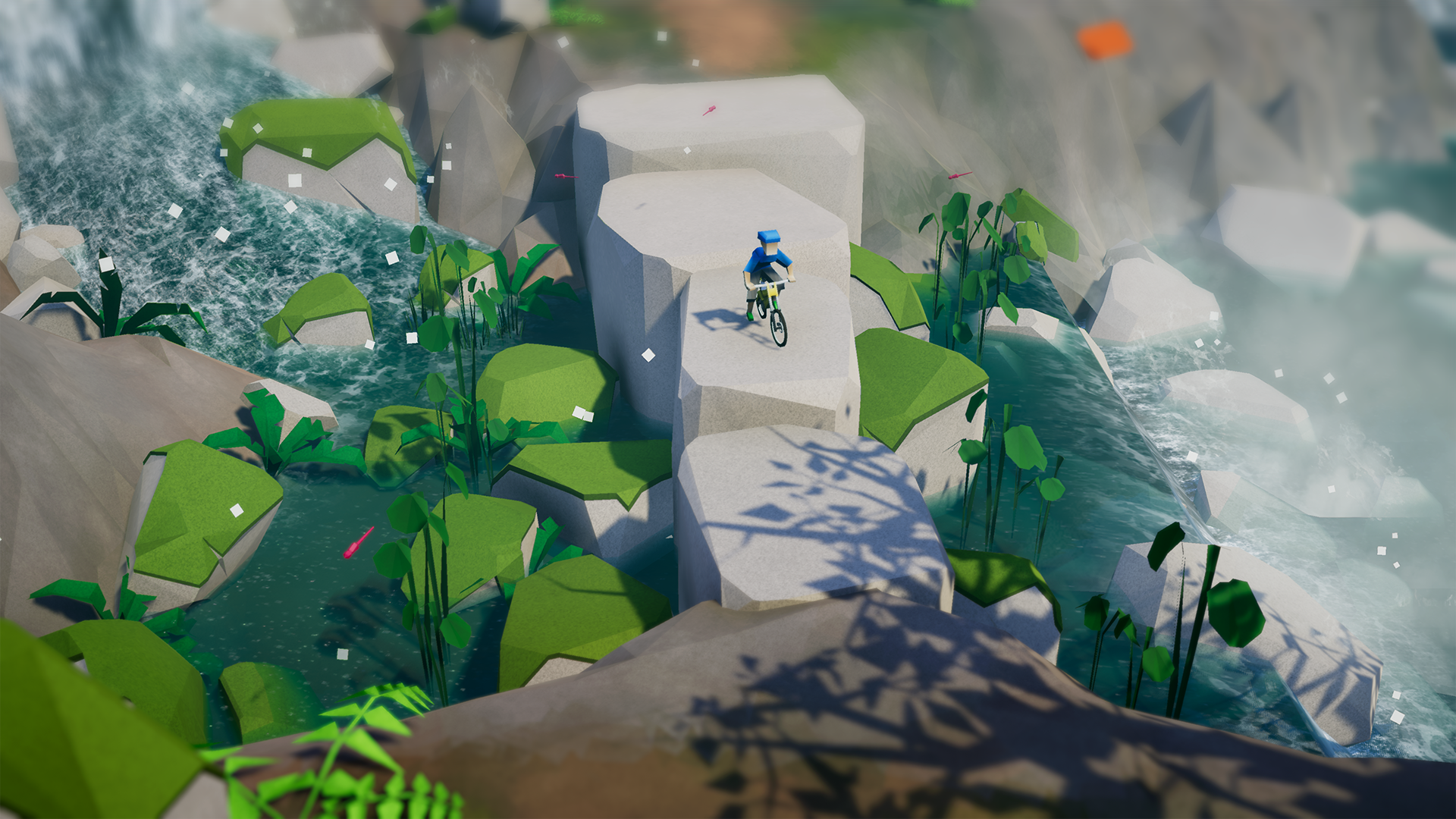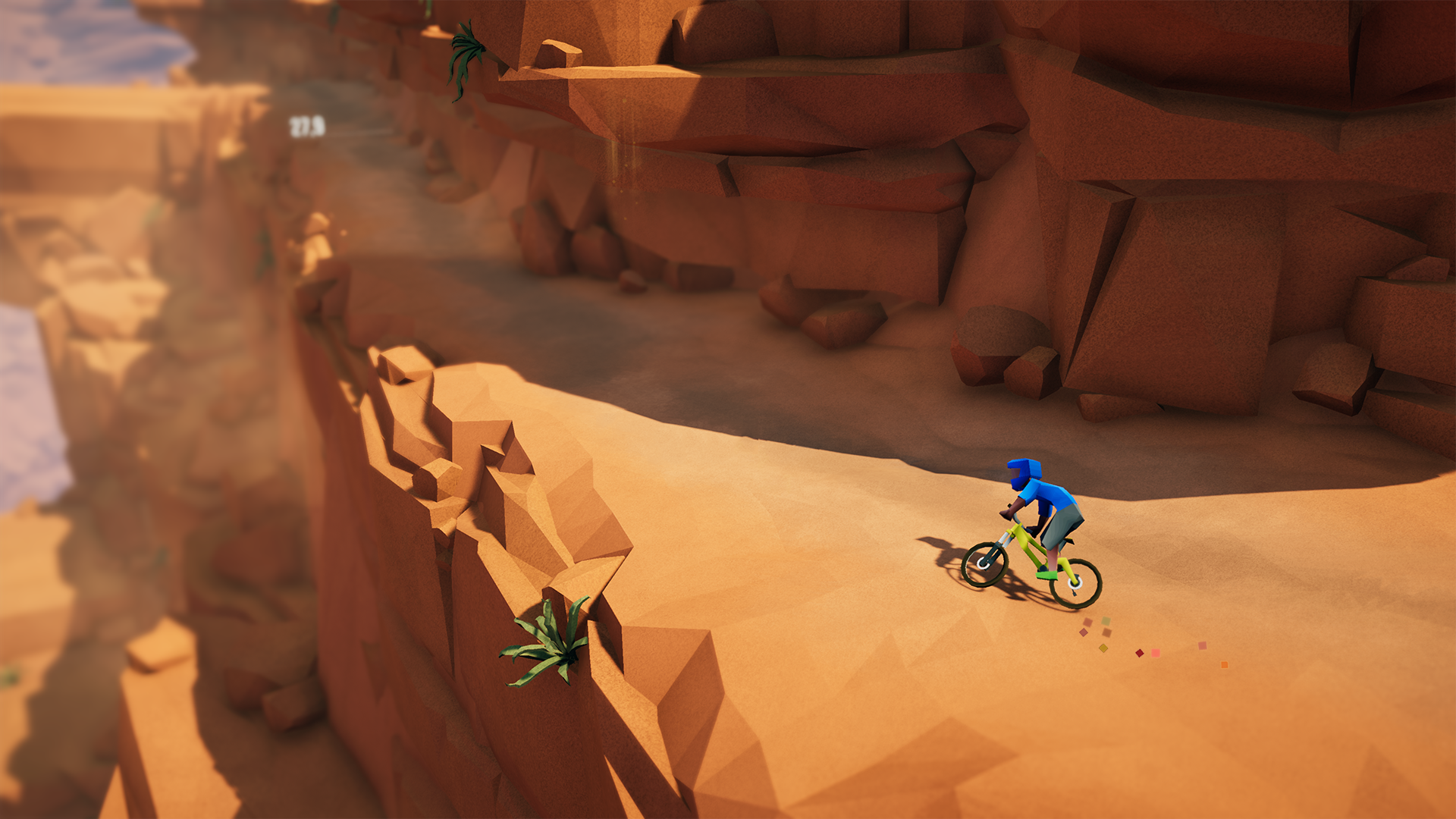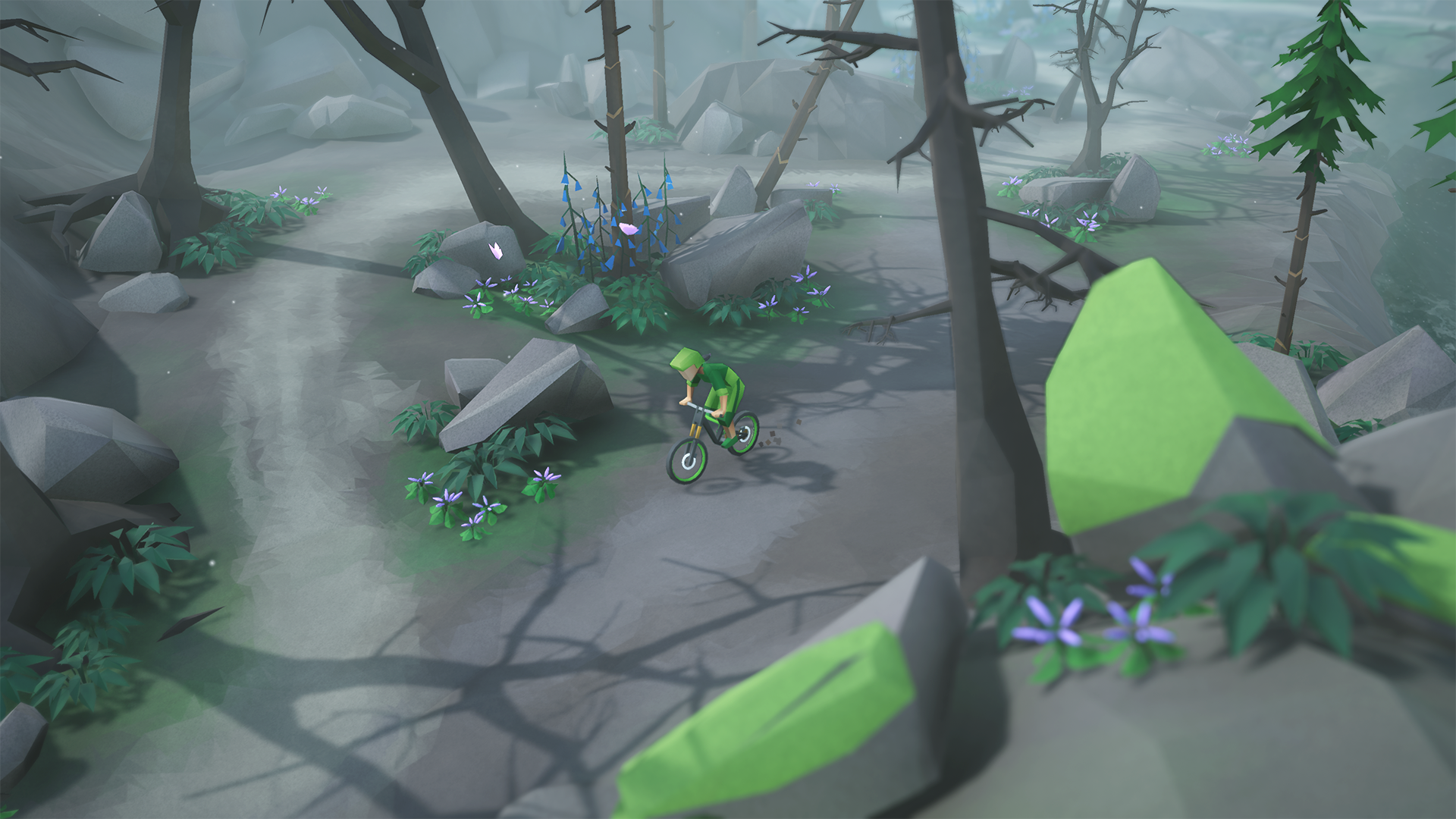Lonely Mountains: Downhill has already succeeded and proved popular on all other gaming platforms due to it’s tranquil ambience, simple design and engaging mechanics, but how has it handled the porting process to the Switch? Find out in this Lonely Mountains: Downhill Switch review!
So before I touch on anything else it probably best I explain what the game is for anyone not familiar. Lonely Mountains: Downhill was originally released in 2019 by German developers Megadon Industries and published by Swedish Company Thunderful following a successful kickstarter campaign. It was initially released on Xbox, PS4 and PC.
The first thing I did when playing the game was attempt to find another game that I could compare it to, I was unable to do so. I suppose one could say it’s close enough to Trials games to appeal to that consumer base but also unique enough to guarantee a whole new player experience.
The TL:DR of what the game itself is about. You start at the top of a mountain and you have to take various routes and shortcuts in order to get to the bottom of the mountain as quickly as possible. Simple in design, simple in motion.
Contents
Gameplay
Now the game in general is hugely simplistic, both in style and in gameplay. The game consists of 4 different mountains, each containing 4 different tracks. 16 tracks total. You start with one track available to you and to unlock the others you must progress through Challenges from the Track prior.
Each track is unique and each mountain adds a different set of challenges. Some mountains are filled with windy corners whereas others are peppered with drops and narrow crossings. They vary enough that no two tracks feel the same.
How are the controls on the switch?
there aren’t many controls to get your head around. right trigger to accelerate, left trigger to break, ‘A’ button to consume stamina in order accelerate swiftly and the left analogue stick to steer. Whether this was on the switch, Xbox, or PlayStation the controls are all alike. So I don’t think there was ever much risk of the porting process falling apart here.
even though the controls are easy enough to learn, the actual handling of the bike and how the analogue stick responds is something that you do have to grow accustomed to. But once you understand the mechanics you begin to realize just how responsive the game is.
The pacing in Lonely Mountains: Downhill
The game paces itself, which for me is great. The first time playing any track there is no timekeeping nor monitoring of crashes . You initially take it at your own pace on “explorer mode”, This is not optional. This allows the player to learn shortcuts and what obstacles you face along the way. After the 50th time face planting into rocks and falling off of cliffs you finally cross the finish line at the bottom of the mountain. With a big pat on the back you then unlock the “beginner challenges” with an understanding of what to expect from the level.
The beginner challenges usually consist of one or two time trials, one being a little more out of reach than the other. In addition to a “Don’t crash” challenge. each challenge completed entitles you to a reward. Some challenges you unlock new skins for the rider or bike, others you get a ‘bike part’ to use as a currency to unlock new bikes(some are fast and good at straights, others are slow and handle falling off cliffs better, The usual).
Lonely Mountain opens itself up track by track, mountain by mountain. The game itself is easy enough to grind through, with the majority of the challenges you need to complete in order to unlock levels being the easier “don’t crash more than X times” challenges. These are really a piece of cake to work through as you can just handle each situation by slamming on your breaks as soon as you pick up the slightest bit of speed. You may finish with a time of 8 minutes instead of the “time trial” goal of 2 but with a new track unlocked, who cares?
Expert mode
Once you have managed to complete the Beginner challenges, you then unlock the expert challenges, which really does turn into a challenge! same two styles of challenges, crash even less times and do it in an even faster time. It is on this mode that you can soon discover your seemingly perfect run was actually a really poor one as you miss the target time by 20 seconds.
Timekeeping in Lonely Mountains: Downhill.

The timekeeping system is also a great idea. The game has accepted that sometimes crashing into an obstacle is unavoidable even for the most elite of players, with the way the physics engine works. They have addressed this with the way the time accumulates. Instead of resuming the clock upon a crash, the time is reverted back to what it was at the start of the checkpoint. What this means is that if you are unhappy with your time on a certain checkpoint. You can just throw yourself off the mountain and you are no worse off than you were at the start.
This really is helpful because some shortcuts are so difficult to take that the crash percentage is bound to be high. This way you aren’t being punished for the risks you take.
Graphics
How does the game look on the Switch?
If there was anything that ran the risk of falling apart for Lonely Mountains. It would be the capabilities that the switch possesses. Now don’t get me wrong, it’s a great console. But it is undeniable that out of all the platforms to release on. The Switch would be the one where changes would need to be made.
The game as a whole is still visibly stunning, the Low Poly design ensures less demand on the capabilities that the Switch possesses whilst also making sure that the game remains pleasing to the eye.
Field of View

Although graphically it’s not all roses. In certain points of the game there is an intentional FOV restriction added. In parts this is no more than an eye sore blur in the distance rather than an actual problem. But on the rare occasion it does become an active hindrance.
The issue isn’t with the blur itself. But more due to the fact that when you are speeding towards the direction of the blur, it doesn’t seem to focus it in as quick as is necessary for you to respond to any obstacles faced within. Periodically I’ve found myself crashing into a rock that only focused in as I was about to hit it.
Despite this, I do believe the blur problem isn’t a huge one to the overall playability of Lonely Mountains: Downhill Switch edition.
Camera Angles
Camera angles on this game are another thing that have been handled really well, Due to the intensity of the game it is vital that the Camera follows you at heights and angles that don’t cause an unnecessary problem to the experience. And there was probably only one or two tracks where I felt that the camera was an issue. where I was driving down a steep slope and the camera was placing itself just behind a load of trees.
Again the pros far outweigh the cons with the camera. The game handles the constant changes in angle and height with such grace you don’t even notice the camera tracking. And any complaints are relatively minor to the overall experience
Night Mode

‘Night mode‘ is available for each Track. But for me it is really underwhelming. It takes the issues that the distance blur contains and dedicates a game mode around it. Don’t get me wrong the shadowing and aesthetics look great. It just isn’t fun.
Audio
The audio is unexpectedly simplistic, yet really adds to the tranquility of what the game provides. Instead of a music track playing in the background, Megadon have decided to make it as natural as possible. Going pedal to the metal trying to beat a time whilst listening to the birds fluttering, the wind blowing and the impact noise the bike makes when hitting the loose dirt is almost therapeutic. For me, this only adds to the immersion.
Replay Value
This game oozes replay value. Even if you were to unlock everything in the game, There is still a reason to continue playing. Whether you are attempting to best your own times set or trying to secure a place on the global leader board, There is something to do.
Having unlocked all the levels and obtaining the bike I wanted, I can’t particularly see myself playing it religiously each and every day. But it’s a great game to play in order to unwind after a long day.
Conclusion
To conclude this ‘Lonely Mountains: Downhill Switch’ review. The game itself has transitioned remarkably onto the Switch. The changes they’ve made to ensure a smooth running are for the most part unnoticeable. If you have an Xbox with the game pass, I’d recommend you opt to get it on the Xbox instead. But if that isn’t an option or you’d like to play the game whilst in handheld mode. Then I’d most certainly say go for it!





Pingback: Game Releases in May: Schedule and Trailers - AIR Entertainment